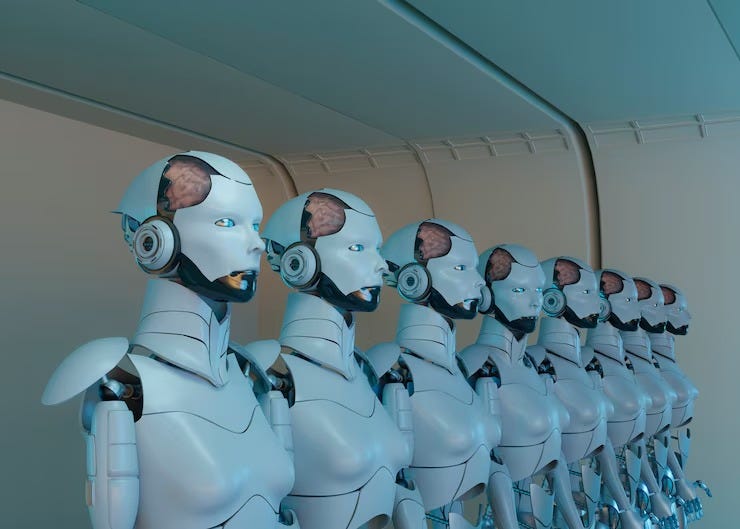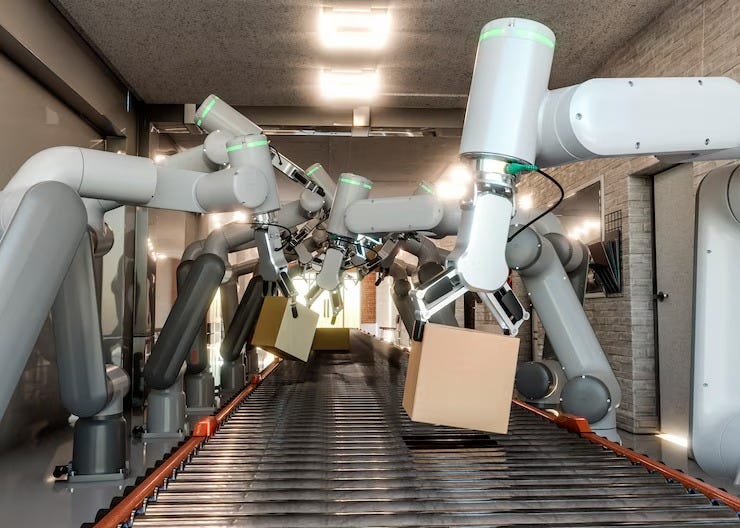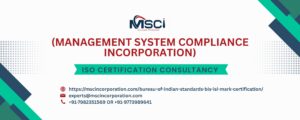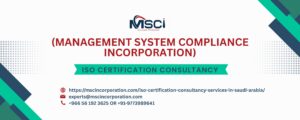
People at job during corona virus pandemic.
The Urgency of Industrial Rebirth
U.S. manufacturing has been in relative decline for decades. Once accounting for over 25% of GDP in the postwar era, the sector now hovers around 11%. This erosion has brought with it regional economic stagnation, supply chain vulnerabilities, and dependence on foreign production — especially from China, which has rapidly scaled its AI and robotics capabilities across industries. Andreessen’s warning is not just about losing market share. It’s about strategic autonomy. The COVID-19 pandemic exposed America’s deep reliance on offshore supply chains. The growing tensions with China, compounded by rapid AI adoption in Chinese industry, have made the stakes higher than ever. Without re-industrialization, the U.S. could find itself outmaneuvered not only economically, but militarily and technologically.
AI as the Catalyst for a Manufacturing Renaissance
Artificial Intelligence, coupled with robotics and advanced analytics, offers a once-in-a-generation opportunity to rebuild American manufacturing. Smart factories that can sense, learn, and adapt in real time are no longer science fiction. These are becoming a strategic necessity.
Modern AI-powered systems can optimize energy usage, reduce waste, predict machine failures before they occur, and dynamically adjust production lines without human intervention. This isn’t about replacing workers with machines, but about augmenting human capabilities with digital precision.
Companies like Relizon AI are at the forefront of this transformation. By integrating generative AI and autonomous agents into manufacturing systems, Relizon AI enables factories to transition from reactive to proactive production environments. Their technology creates intelligent feedback loops that allow systems to improve continuously with minimal human oversight.
According to the National Institute of Standards and Technology (NIST), the rise of AI in U.S. manufacturing is already reshaping industries — from automotive and aerospace to pharmaceuticals and advanced materials. These innovations are not just increasing efficiency — they’re building resilience into the American economy.

The Economic Payoff
The numbers are staggering. According to a 2024 McKinsey report, the global AI-driven manufacturing market could contribute $3.7 trillion annually to the global economy by 2035 (source). For the U.S., reinvesting in manufacturing through AI could revive rust belt regions, create millions of high-skill jobs, and spark a new era of industrial entrepreneurship. Stanford’s 2025 AI Index reinforces this vision, reporting that U.S. private investment in AI reached a record $109 billion in 2024 — nearly twelve times that of China. This capital surge reflects a growing awareness that AI-driven productivity is not just optional — it’s critical for long-term competitiveness. Venture capital firms and federal policy circles are beginning to respond. The proposed “Stargate” AI infrastructure bill seeks to invest $100 billion before 2029 to build a national network of AI-ready industrial facilities. These would be equipped not just with high-performance compute resources, but also with the standards and cybersecurity protocols necessary for safe deployment.
The Workforce Transition
But a digital industrial revolution is not without its challenges. Chief among them is the workforce. Automation has long been seen as a job killer. Yet the truth is more nuanced. While low-skill repetitive jobs may diminish, new roles in AI oversight, machine ethics, robotics maintenance, and cyber-physical systems design are emerging rapidly. The key is education and retraining. Community colleges, technical schools, and vocational training centers need to become hubs of continuous learning. Programs like “AI for the Trades” are already showing promise in states like Michigan and Ohio. Companies must partner with local governments and educational institutions to co-develop curricula that match the skills required in AI-enabled factories. Relizon AI has taken a leadership role here as well, launching a joint initiative with Midwest polytechnic institutes to train 1,000 technicians annually in AI-integrated factory operations. This model of public-private partnership is critical for scaling up the talent pipeline.
Competing with China: The Geopolitical Stakes
China’s “Made in China 2025” plan has aggressively pushed AI integration in manufacturing, with state-backed investments dwarfing those of the U.S. (source). Their smart factories are not merely about productivity; they are central to China’s strategy to dominate global supply chains and critical technologies.
If the U.S. fails to act swiftly, it risks becoming a buyer rather than a builder — dependent on foreign platforms for critical components, from semiconductors to EV batteries. AI-native manufacturing isn’t just a technological trend; it’s a geopolitical necessity.
To compete effectively, the U.S. must:
- Streamline regulations to encourage innovation while safeguarding ethical standards.
- Invest in AI infrastructure akin to the New Deal scale projects.
- Cultivate an industrial innovation ecosystem that bridges startups, academia, and legacy manufacturers.

Responsible Automation: Ethics and Resilience
AI-powered manufacturing also raises important ethical considerations. Systems must be transparent, secure, and auditable. Worker surveillance, algorithmic bias, and environmental sustainability cannot be afterthoughts. Responsible automation means embedding AI governance from the ground up. Companies should adopt frameworks like NIST’s AI Risk Management Framework to ensure that systems align with democratic values and human rights. Relizon AI, for instance, integrates explainability modules and bias detection algorithms directly into their factory AI stack, allowing for transparent decision-making and compliance audits.
Conclusion: A Call to Action
The U.S. stands at a crossroads. The choice is stark: either embrace a future where AI-powered manufacturing restores national strength and technological leadership, or continue down a path of industrial decay and strategic vulnerability.
Marc Andreessen’s warning is not hyperbole — it’s a blueprint. The tools exist. The need is urgent. What remains is the will to act.
With pioneers like Relizon AI demonstrating what is possible, the path forward is clear. America must build again. Not with the tools of the past, but with the intelligence of the future.
Only then can it secure its place in the AI age — not as a follower, but as a leader.



